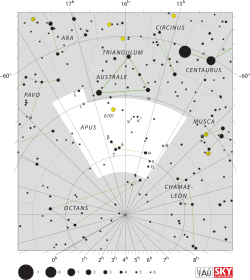Eta Apodis
Eta Apodis, Latinized from η Apodis, is a star in the southern circumpolar constellation Apus. Based upon parallax measurements from the Hipparcos mission, it is approximately 141 light-years (43 parsecs) from Earth. With an apparent visual magnitude of +4.9,[2] it can be viewed with the naked eye from the southern hemisphere.
 | |
| Observation data Epoch J2000 Equinox J2000 | |
|---|---|
| Constellation | Apus |
| Right ascension | 14h 18m 13.89774s[1] |
| Declination | −81° 00′ 27.9300″[1] |
| Apparent magnitude (V) | +4.89[2] |
| Characteristics | |
| Spectral type | A2MA7-F2[3] or A2(m) CrEu[4] |
| U−B color index | +0.11[5] |
| B−V color index | +0.25[5] |
| Astrometry | |
| Radial velocity (Rv) | −9.4[2] km/s |
| Proper motion (μ) | RA: −19.854 ± 0.227[6] mas/yr Dec.: −65.413 ± 0.222[6] mas/yr |
| Parallax (π) | 23.1651 ± 0.1430[6] mas |
| Distance | 140.8 ± 0.9 ly (43.2 ± 0.3 pc) |
| Absolute magnitude (MV) | +1.76[7] |
| Details | |
| Mass | 1.77[8] M☉ |
| Radius | 2.13[8] R☉ |
| Luminosity | 15.5[8] L☉ |
| Temperature | 7,860 ± 20[8] K |
| Rotational velocity (v sin i) | 17.2 ± 0.3[9] km/s |
| Age | 250 ± 200[8] Myr |
| Other designations | |
| Database references | |
| SIMBAD | data |
Properties
This star has about 1.77 times the mass of the Sun and 2.13 times the Sun's radius. It is radiating 15.5 times the luminosity of the Sun from its outer atmosphere at an effective temperature of 7,860 K.[8] Eta Apodis is a young star with an age of about 250 million years.[8]
The stellar classification of Eta Apodis shows this to be an Am star, which means the spectrum shows chemically peculiarities. In particular, it is an A2-type star showing an excess of the elements chromium and europium. The spectrum displays magnetically-induced features indicating an estimated surface field strength of roughly 360 G.[4] Based upon observations with the Spitzer Space Telescope, this system is emitting an excess of 24 μm infrared radiation. This may be caused by a debris disk of dust orbiting at a distance of more than 31 astronomical units from the star.[8]
Naming
In Chinese caused by adaptation of the European southern hemisphere constellations into the Chinese system, 異雀 (Yì Què), meaning Exotic Bird, refers to an asterism consisting of η Apodis, ζ Apodis, ι Apodis, β Apodis, γ Apodis, δ1 Apodis, α Apodis and ε Apodis. Consequently, η Apodis itself is known as 異雀七 (Yì Què qī, English: the Seventh Star of Exotic Bird.)[11]
References
- van Leeuwen, F. (November 2007). "Validation of the new Hipparcos reduction". Astronomy and Astrophysics. 474 (2): 653–664. arXiv:0708.1752. Bibcode:2007A&A...474..653V. doi:10.1051/0004-6361:20078357.
- Wielen, R.; et al. (1999), Sixth Catalogue of Fundamental Stars (FK6). Part I. Basic fundamental stars with direct solutions, Astronomisches Rechen-Institut Heidelberg, Bibcode:1999VeARI..35....1W
- Houk, Nancy (1979), Michigan catalogue of two-dimensional spectral types for the HD stars, 1, Ann Arbor, Michigan: Dept. of Astronomy, University of Michigan, Bibcode:1978mcts.book.....H
- Bychkov, V. D.; Bychkova, L. V.; Madej, J. (August 2003), "Catalogue of averaged stellar effective magnetic fields. I. Chemically peculiar A and B type stars", Astronomy and Astrophysics, 407: 631–642, arXiv:astro-ph/0307356, Bibcode:2003A&A...407..631B, doi:10.1051/0004-6361:20030741
- Johnson, H. L.; et al. (1966), "UBVRIJKL photometry of the bright stars", Communications of the Lunar and Planetary Laboratory, 4 (99), Bibcode:1966CoLPL...4...99J
- Brown, A. G. A.; et al. (Gaia collaboration) (August 2018). "Gaia Data Release 2: Summary of the contents and survey properties". Astronomy & Astrophysics. 616. A1. arXiv:1804.09365. Bibcode:2018A&A...616A...1G. doi:10.1051/0004-6361/201833051.
- Anderson, E.; Francis, Ch. (2012), "XHIP: An extended hipparcos compilation", Astronomy Letters, 38 (5): 331, arXiv:1108.4971, Bibcode:2012AstL...38..331A, doi:10.1134/S1063773712050015.
- Plavchan, Peter; et al. (June 2009), "New Debris Disks Around Young, Low-Mass Stars Discovered with the Spitzer Space Telescope", The Astrophysical Journal, 698 (2): 1068–1094, arXiv:0904.0819, Bibcode:2009ApJ...698.1068P, doi:10.1088/0004-637X/698/2/1068
- Díaz, C. G.; et al. (July 2011), "Accurate stellar rotational velocities using the Fourier transform of the cross correlation maximum", Astronomy & Astrophysics, 531: A143, arXiv:1012.4858, Bibcode:2011A&A...531A.143D, doi:10.1051/0004-6361/201016386
- "eta Aps -- Star", SIMBAD, Centre de Données astronomiques de Strasbourg, retrieved 2012-07-08.
- (in Chinese) AEEA (Activities of Exhibition and Education in Astronomy) 天文教育資訊網 2006 年 7 月 29 日